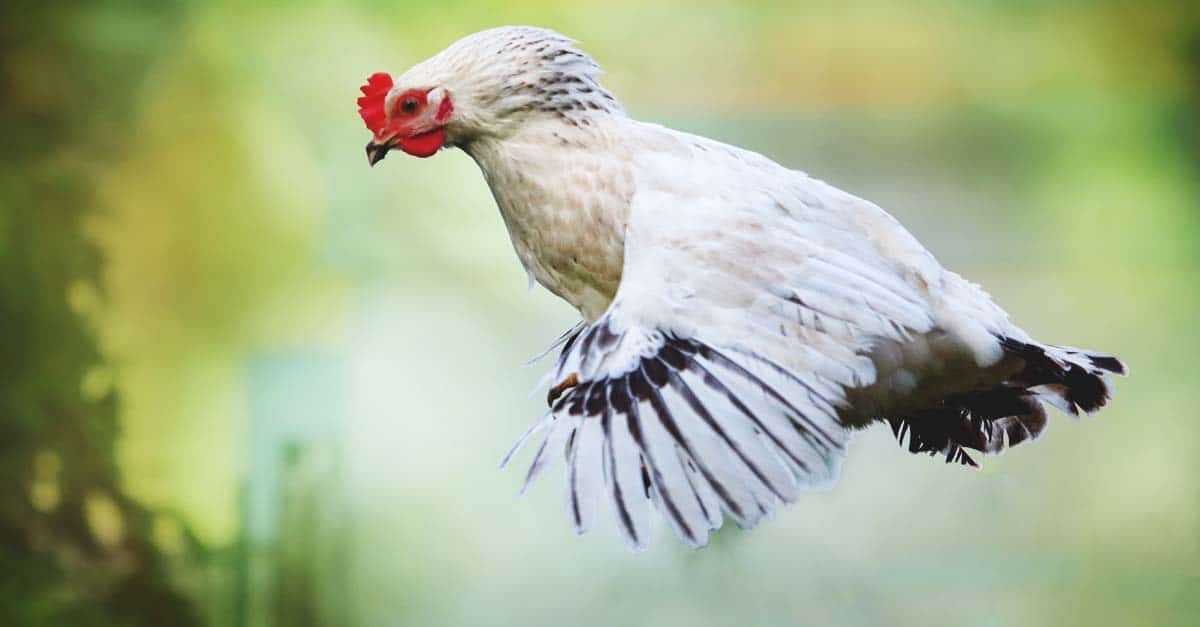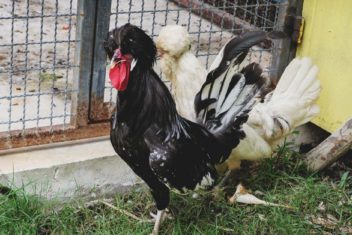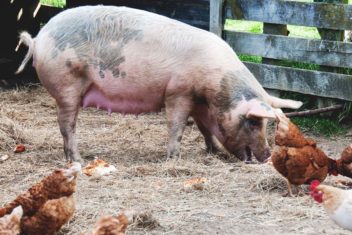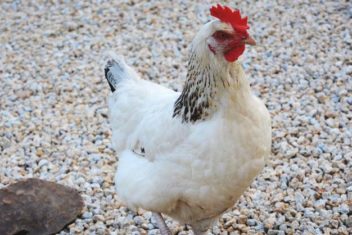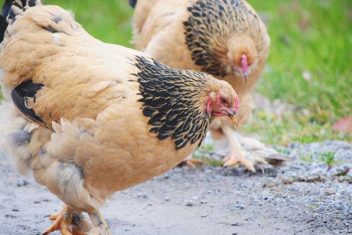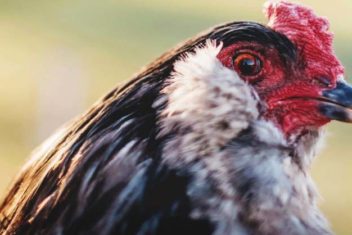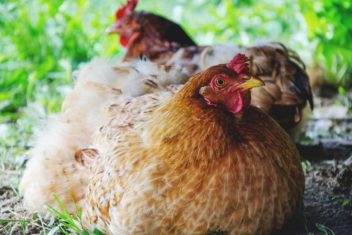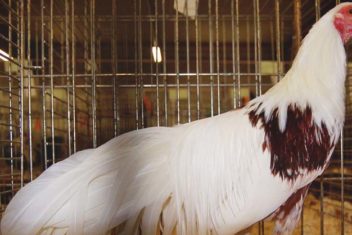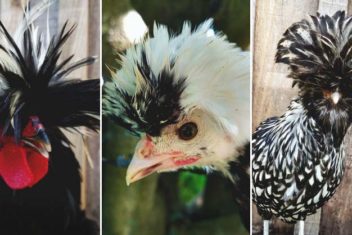Chickens aren’t known for their awesome ability to fly. In reality, most chickens can’t get very far off the ground – although they do have the capability of catching some air when they really want to.
However, as any chicken keeper knows, the ability for a chicken to fly – even short distances – can be a major headache. In the wild, chickens can not only fly high enough to get away from predators, but they can also get enough leverage to perch and roost in trees.
If you’re keeping domestic chickens, you may struggle with chicken breeds that are more flighty than others. Not only can it be tough to catch a chicken when you need to wrangle it, but it’s also difficult to keep it enclosed in a pen.
Here’s everything you need to know about how to manage flighty chickens.
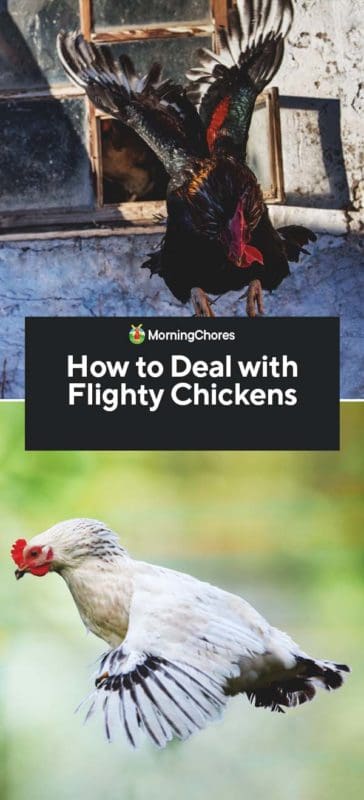
What is a Flighty Chicken?
A flighty chicken is simply one that has a greater inclination to fly than others. All chickens have the innate ability to fly, but very few will actually be good at it.
There’s really no problem with raising a flighty chicken – unless you have concerns about keeping it contained. We have raised flighty chickens in the past and had trouble with them leaping over the fences we’ve built to keep out predators. The chickens were, in fact, putting themselves in harm’s way by ignoring the barriers we had built!
As a result, we had to do some work to figure out how to nip this flighty, escapist behavior in the bud.
Be Aware of These Most Flighty Chicken Breeds
New Hampshire Reds and Golden Comets, pictured here, aren’t known to be the flightiest breeds – but they do occasionally take flight!
If you’re reading this article and already have a flock of chickens, there’s not much you can do to change the breed disposition toward flightiness. What you have is what you have!
But if you’re new to raising chickens and want to prevent flighty behavior before it becomes a problem, think carefully about the breed of chicken you select. You don’t usually need to worry about large, heavy breeds like Orpingtons or Wyandottes flying too much. The real escape artists are lighter breeds.
If you’re raising meat birds, you won’t have to worry too much about it taking flight. Common broiler species like Cornish Crosses and Jersey Giants are so heavy that they can usually only get about a foot off the ground. Their wings are simply too underpowered to handle the weight of their bodies.
The breeds you really need to worry about are lighter breeds – typically, those from the Mediterranean region. Often, these chickens are the ones raised as pets or for egg production.
Flighty breeds include Anconas, Leghorns, Fayoumis, and Araucanas. These birds are not only capable of taking flight due to their light bodyweight, but they absolutely love doing it. They will roost in trees if given the chance – something that can be a real pain when you’re trying to get your chickens locked into the coop at night.
Some other flighty breeds to be aware of include Spitzhaubens (a Swiss breed), Red Rangers, and any bantam breed. Bantam chickens are especially skilled at flight because they are so tiny. The exceptions to this are Silkie and Polish bantams – for whatever reason, these chickens aren’t prone to flightiness.
Tips for Keeping Your Birds Contained
Here are some of the best recommendations for eliminating (or at least controlling the effects of) flighty behavior in your flock.
1. Understand the Reasons for Flightiness
Provide plenty of food and water stations to keep your chickens happy.
The best way to eliminate flighty behavior is to first understand the root of the problem. After all, isn’t it better to treat the cause rather than the symptom?
Chickens are flighty for two different reasons: determination and curiosity, with curiosity often paramount.
Chickens will often take a short flight over to the neighbor’s yard out of sheer curiosity. The grass is always greener on the other side, and that’s particularly true if your neighbors have a gorgeous lawn, a vegetable garden, or other areas with plenty of tasty treats for your chickens to sample.
They may also fly the coop, so to speak, if they feel threatened in any way. Any chicken keeper who has ever attempted to wrangle an anxious escaped chicken back into the coop probably already knows this – if you spook a bird, it’s going to be more likely to try to fly away from you.
2. Build Preventative Fences and Housing
Chicken tractors can be moved each day for fresh pasture and help keep curious chickens contained.
The first – and perhaps most obvious – step you can take in handling your flighty chickens is to build systems that keep them in place. If you don’t already have fences in place, build some! Make sure you erect fences that are several feet tall to prevent chickens – even non-flighty breeds – from simply hopping over them.
A tall fence is important not just to keep your flightier birds in, but also to protect against predators. It’s not a bad idea to bury part of the fence to protect against digging predators, as well as to line the top with barbed wire to deter climbing carnivores.
If you have super flighty birds, you might want to consider completely covering the run. This will completely eliminate the ability of your birds to take flight and escape. Of course, if you want to raise pastured birds who have continuous access to fresh grass, this can be prohibitive.
A good solution is to raise your chickens in chicken tractors. These facilities are moved every day or every other day, allowing your birds to always have access to fresh pasture. There are countless designs when it comes to chicken tractors, with some taking hoop house-style layouts and others that are significantly less elaborate.
Chicken tractors aren’t a great solution when there’s heavy snowpack – but if you want chickens on fresh pasture, that’s a moot point. Grass won’t grow under the snow, so you’re best to move the birds to winter housing, anyway! Building a chicken tractor ensures that your birds can “free-range” – but can’t get too far to get themselves into trouble.
3. Clip Wings
One of the first lines of defense in keeping flighty chickens at home is to clip their wings. There are lots of people who will balk at this idea, thinking that it’s inhumane to clip wings. However, this is not the case.
The idea here is not to cut off the entire wing of a bird – it is just to trim the flight feathers of one wing so that the bird is imbalanced and cannot get enough momentum to lift off from the ground. You are only trimming the flight feathers, which doesn’t inflict any pain on your birds in the slightest.
The key here is to only cut through the hollow quills of the feather. If you cut too deeply or cut into any emerging pin feathers after molting, you can cause serious pain and bleeding. You will also need to retrim feathers after the molt each year, as new feathers will grow in to replace the ones that were lost.
4. Brailing
If you raise chickens for exhibition purposes, you cannot clip wings. This disqualifies them from showing. However, you can brail them. Brailing is a simple process that involves binding the wing with a soft cord so the wing can’t be opened up for flight.
You need to be careful when brailing to prevent over-tightening of the binding. This can constrict blood flow. In addition, you need to remove the brail each week and apply it to the other wing to prevent disability.
Brailing isn’t a super common technique because it is more time consuming and can be more inhibiting to your flock. Obviously, it’s not a great solution for people who raise large amounts of chickens, either. But if you raise exhibition birds, it’s a good alternative to clipping wings.
5. Reduce Curiosity
A few years ago, when we kept chickens in pastured pens with a solar fence that we moved daily, I came home to find the entirety of my flock pecking and scratching in my garden.
Not only did we lose a few birds to predators that day, but we also lost all of our freshly planted seedlings.
The mistake was ours, however. We had not moved the solar fence in a few days, and so the chickens had become bored with the scratched-over pasture. As a result, they decided to fly over the fence to check out the nearby garden.
Remember, the grass is always greener on the other side – and chickens are undeniably curious about that grass! Eliminate the need for your chickens to take flight in search of greener pastures. You can do this by ensuring they always have access to fresh food and water, and that there is plenty of space for all of your birds. Plus you can give them their very own chicken garden.
Chickens who feel crowded, threatened, or in any way deprived are going to be much more likely to take flight than those who are well-fed and entertained. Don’t run the risk of potentially damaging flighty behavior by not meeting some of your chickens’ most basic requirements!
6. Learn How to Handle Your Birds
If your chickens do happen to take flight, don’t panic. They’re easy to catch as long as you know what you are doing.
Sure, you can chase your chicken around the yard to see who gets tired out first. But chances are, it’s going to be you – not your chicken. In addition, she’s going to be more likely to take flight, potentially to an area that you can’t reach – like a treetop.
Instead, try to entice your chicken back to the others by using incentives like treats. If that doesn’t work, you can wait until nightfall. Chances are, if you haven’t spooked her too much, she’s going to head back to the coop to the roost.
Even if she can’t get back to her flockmates (for example, if she’s having trouble flying back over the fence or getting into the coop), she’ll likely circle the area she’s used to going home to until somebody lets her back in.
Why You Need to Keep an Eye on Flighty Chickens
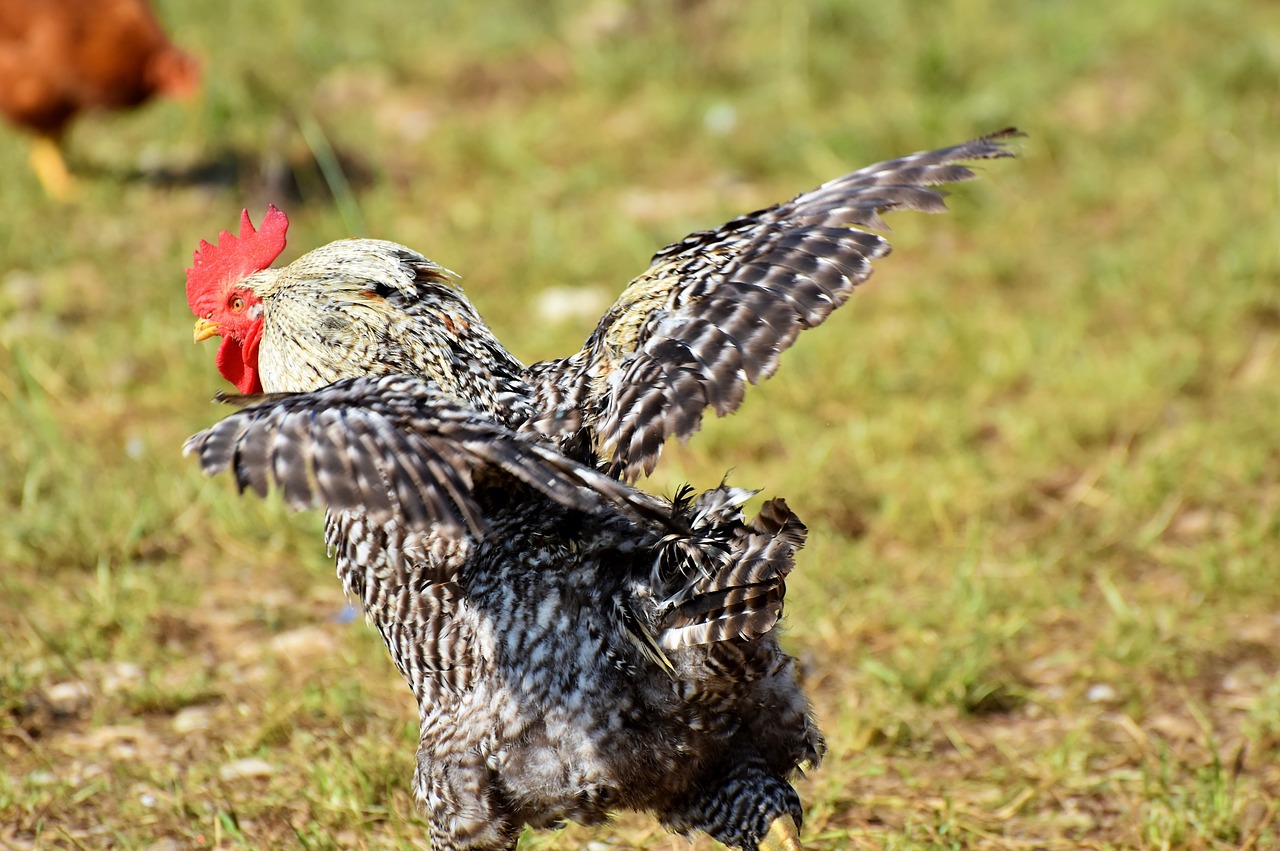
It’s easy to laugh off flighty behavior and assume that since your chickens are acting out a natural impulse to fly, it can’t possibly do them any harm. That’s not the case.
There are plenty of good reasons to keep your flighty chickens contained. Not only can an escapee chicken easily wreak havoc on your neighbor’s yard (or your very own vegetable garden!) but it’s also important to keep your flighty chickens home for their own safety. Once your chickens are out of your sight and the protection of the fences you have perfected, they are fair game for predators.
Plus, a chicken who flies a far distance from her home – either out of curiosity or because she was spooked – can become so disoriented that she never finds her way back. Chickens that fly far from the coop rarely make it back to their flock mates.
If you have chickens that are prone to flighty behavior, consider implementing some of these tips. It will keep your chickens at home, helping them to stay safe and protected – and it will help eliminate tensions between you and your neighbors, too!
